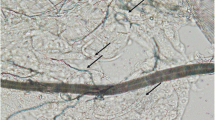Summary
Larvae of the parasitic wasp Habrobracon juglandis fed with cater-pillars of the meal moth Ephestia kühniella which are infected with the schizogregarine Mattesia dispora are able to take up all stages of the parasite. Only sporozoites and presumably trophozoites can penetrate the gut wall and develop into spores in the fat body. Micro- and macronuclear schizogonies as well as gamogony and sporogony in the hymenopteran host are described. Micro- and macronuclear plasmodia are smaller in Habrobracon than in Ephestia. The products of macronuclear schizogony — spheric and spindlelike merozoites — seem to be sexually differentiated. They have large or small cytoplasmic vacuoles. This structural difference is seen up to formation of syzygy. There is no mating of gametes but of gamete nuclei. The development of Mattesia in Habrobracon is terminated at 30° C after ten days and requires only a third of time as in Ephestia. It is imaginable that the parasite can by a feed back mechanism accelerate to a more or lesser extent his own development according to the host.
Zusammenfassung
Werden Ephestia-Raupen, die mit Mattesia dispora befallen sind, von der ektoparasitischen Brackwespe Habrobracon juglandis parasitiert, so nehmen deren Larven alle Entwicklungsstadien dieser Schizogregarine auf. Nur die Sporozoiten und wahrscheinlich die Trophozoiten vermögen die Darmwand zu durchdringen und sich im Fettkörper zu entwickeln. Es werden mikro- und makronucleäre Schizogonie sowie Gamogonie und Sporogonie im Hymenopterenwirt beschrieben. Die Plasmodien der 1. und 2. Schizogonie sind kleiner als im Ephestia-Wirt. Zum Abschluß der makronucleären Schizogonie werden sowohl Kugel- als auch Spindelmerozoiten gebildet. Beide sind oft mit unterschiedlich großen Cytoplasmavakuolen ausgestattet, was als Anzeichen einer zweigeschlechtlichen Differenzierung gedeutet wird, zumal diese strukturelle Verschiedenheit bis zu den Syzygien zu verfolgen ist. Die Ausbildung von Gameten wurde nicht beobachtet; es verschmelzen Gametenkerne. Der Entwicklungszyklus in Habrobracon erfordert mit 10 Tagen bei 30° C nur ein Drittel der Entwicklungsdauer in Ephestia. Es ist denkbar, daß der Parasit je nach Wirt seine eigene Entwicklung durch eine Art Rückkoppelungsmechanismus mehr oder weniger beschleunigen kann.
Similar content being viewed by others
Literatur
Grell, K. G.: Der Kernphasenwechsel von Stylocephalus (Stylorhynchus) longicollis F. Stein. Arch Protistenk. 94, 161–200 (1940).
— Sexual reproduction in protozoa. In: Tze-Tuan Chen (ed.), Research in protozoology, vol. 2, p. 148–213. Oxford: Pergamon Press 1967.
— Protozoologie. Berlin-Heidelberg-New York: Springer 1968.
Leibenguth, F.: Entwicklungsphysiologisch-genetische Untersuchungen am Tryptophanstoffwechsel zweier Genotypen von Habrobracon juglandis Ashmead. Wilhelm Roux' Arch. Entwickl.-Mech. Org. 158, 246–300 (1967).
— Veränderungen der Haemolymphe ausgewachsener Ephestia-Raupen nach Infektion mit Mattesia dispora. Z. Parasitenk. 33, 235–245 (1970).
Naville, A.: Recherches cytologiques sur les schizogrégarines. I. Le cycle évolutif de Mattesia dispora n. g., n. sp. Z. Zellforsch. 11, 375–396 (1930).
Weiser, J.: Zur systematischen Stellung der Schizogregarinen der Mehlmotte, Ephestia kühniella Z. Arch. Protistenk. 100, 127–142 (1954).
Author information
Authors and Affiliations
Rights and permissions
About this article
Cite this article
Leibenguth, F. Die Entwicklung von Mattesia dispora in Habrobracon juglandis . Z. Parasitenk. 38, 162–173 (1972). https://doi.org/10.1007/BF00329028
Received:
Issue Date:
DOI: https://doi.org/10.1007/BF00329028




